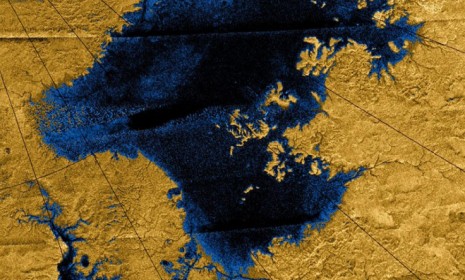Is Saturn's moon Titan even more Earth-like than we thought?
Scientists reveal that underneath thick layers of cloud cover, the moon's icy surface has complex river networks and a remarkably smooth landscape

Saturn's mysterious moon Titan has long intrigued scientists, but historically they've had a hard time studying the moon's terrain because it's surrounded by a thick orange haze. In 2004, NASA's unmanned Cassini spacecraft was finally able to penetrate Titan's murky fog, beaming geological images back to earth. Researchers from MIT and and the University of Tennessee at Knoxville who have been studying those images recently concluded that the moon's icy surface is surprisingly Earth-like in a number of ways. Here's what you should know:
What does Titan's surface look like?
It's remarkably crater-free, suggesting that the moon's outermost layer is constantly reshaping itself, just like Earth. Titan's landscape also boasts a number of swirling rivers that flow into giant lakes, mirroring our planet's water systems. Key difference: Titan's rivers are full of liquid methane, not water.
The Week
Escape your echo chamber. Get the facts behind the news, plus analysis from multiple perspectives.

Sign up for The Week's Free Newsletters
From our morning news briefing to a weekly Good News Newsletter, get the best of The Week delivered directly to your inbox.
From our morning news briefing to a weekly Good News Newsletter, get the best of The Week delivered directly to your inbox.
Are there other differences?
For the most part, Titan's rivers don't flow with the same force as most rivers on Earth. Rather, they trickle slowly through Titan's dense ice, in thinner, tree branch-like networks. They're "more on the long and spindly side," says MIT graduate student Benjamin Black, kind of like the winding rivers flowing through the volcanic terrain on the Hawaiian island of Kauai.
How, specifically, has Titan's surface been reshaping itself?
While most moons in the solar system are dented all over with craters, Titan's surface is relatively smooth, the result, scientists theorize, of geological changes similar to ones that have happened on our planet. On Earth, for example, craters are a rarity because "plate tectonics, erupting volcanoes, advancing glaciers, and river networks have all reshaped Earth's surface over billions of years," says the Daily Galaxy. On Titan, similar processes — like icy lava eruptions, erosion, and sedimentation — are constantly reshaping it.
A free daily email with the biggest news stories of the day – and the best features from TheWeek.com
Source: Daily Galaxy, Daily Mail, Science Daily, Space.com
-
 ‘They’re nervous about playing the game’
‘They’re nervous about playing the game’Instant Opinion Opinion, comment and editorials of the day
-
 Will Netanyahu get a pardon?
Will Netanyahu get a pardon?Today's Big Question Opponents say yes, if he steps down
-
 December’s books feature otherworldly tales, a literary icon’s life story and an adult royal romp
December’s books feature otherworldly tales, a literary icon’s life story and an adult royal rompThe Week Recommends This month's new releases include ‘The Heir Apparent’ by Rebecca Armitage and ‘Tailored Realities’ by Brandon Sanderson